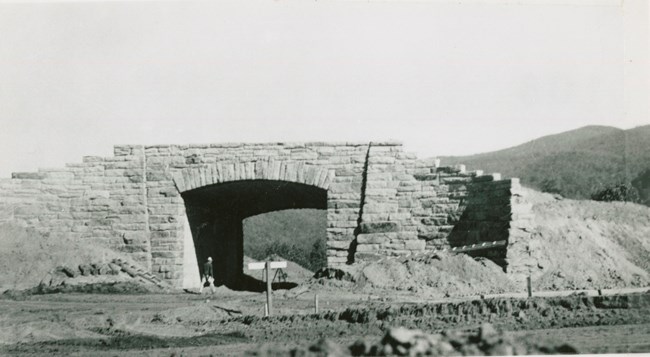
The most distinctive architectural feature of the Blue Ridge Parkway is its outstanding collection of bridges and grade separation structures, which allow the parkway to cross streams or pass safely over or under other roads. Many of these 168 structures have a rustic stone appearance that blends well with the mountain landscape; others are sleek modern steel and reinforced concrete structures. Bureau of Public Roads engineers and National Park Service landscape architects collaborated on the design of the parkway bridges. Many of the grade separation structures appear to be old-style stone arch bridges but are actually reinforced concrete structures. They were constructed by erecting stone arch rings, abutments and spandrel walls, then pouring concrete on a network of steel reinforcing rods. The stonework is not merely decorative, but serves as the form for the concrete frame. All but one of the overpasses, or grade separation structures carrying roadways over the parkway, are stone-faced arch structures. Many underpasses bearing the parkway over other roads are stone-faced arch structures as well. The stone facing for these structures was a hallmark of the rustic style of architecture employed by the National Park Service, which dictate the use of materials that would enable structures to harmonize with their environments. The stone was generally obtained from quarries located near the construction site. In other cases, stone was obtained from rock cuts created during the construction of the roadway. As the parkway traverses several distinct geological areas over its nearly 500-mile length, the type and appearance of the stone used in the work varies from location to location. Different arch shapes were employed, the choice being dictated by the length of span and topographic conditions. Most were segmental arches rising from straight-sided abutment walls. The elliptical arch was occasionally used where there was sufficient horizontal clearance to carry the arch all the way to the ground, usually where the parkway intersected primary roads. Circular arches were employed for some narrower spans. Many bridges are curved or skewed, crossing a road or stream on a diagonal so as not to interrupt the flow of the roadway.
Text excerpted from "Highways in Harmony" publication produced by Historic American Engineering Record (HAER), in cooperation with the National Park Foundation.
|
Last updated: April 14, 2015
